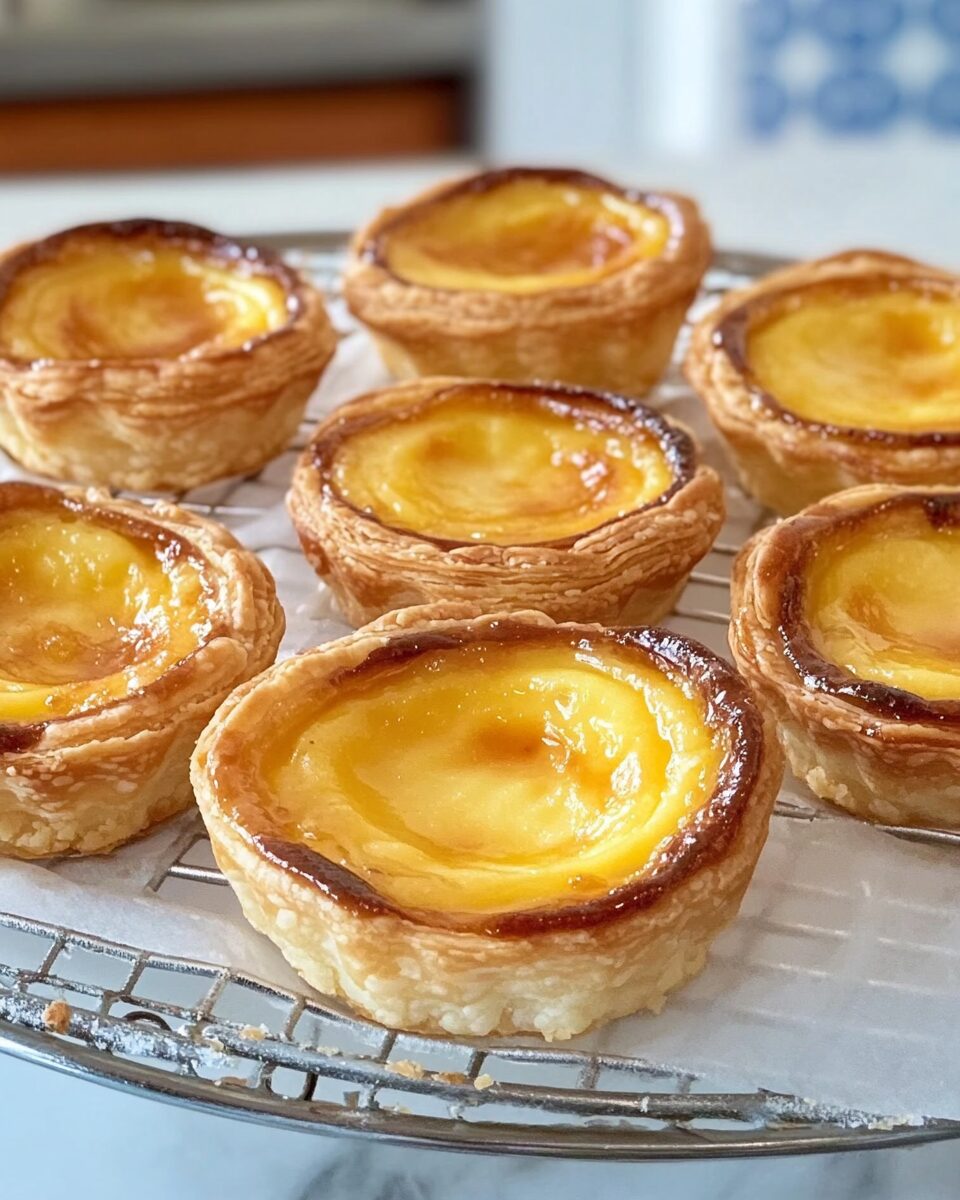Portuguese Custard Tarts, or Pastéis de Nata, are the quintessential Portuguese pastry, celebrated for their rich, creamy custard filling and crispy, caramelized top. Wrapped in delicate, flaky layers of puff pastry, these golden tarts are a perfect harmony of textures and flavors. With a touch of cinnamon and powdered sugar to finish, they are a treat for the senses.
These tarts have a long history rooted in Portuguese monasteries, where egg yolks were used in abundance for both cooking and cleaning. Today, this dessert continues to be beloved not only in Portugal but around the world. Serve them warm for an extra indulgent experience, whether it’s for a special occasion or simply to savor a taste of Portuguese tradition.
Full Recipe:
- 1 (14-ounce) package puff pastry
- 2 cups whole milk
- 1 tablespoon cornstarch
- 1 cup granulated sugar
- 1/3 cup water
- 6 large egg yolks
- 1 teaspoon vanilla extract
- Ground cinnamon, for dusting
- Powdered sugar, for dusting
Directions:
- Preheat your oven to 400°F (200°C).
- Roll out the puff pastry on a lightly floured surface and cut into circles that fit into the cups of a standard muffin tin. Press each circle into the cups, forming small tart shells. Refrigerate while preparing the filling.
- In a saucepan, whisk together 1/2 cup of the milk with the cornstarch until smooth. Add the remaining milk and cook over medium heat until the mixture thickens slightly, stirring constantly.
- In a separate pan, combine the sugar and water. Bring to a boil and cook until the mixture reaches 220°F (105°C) on a candy thermometer. Slowly pour the sugar syrup into the milk mixture, whisking continuously.
- In a bowl, whisk the egg yolks and vanilla extract. Gradually add the warm milk and sugar mixture to the yolks, whisking constantly to prevent curdling.
- Remove the tart shells from the fridge and pour the custard filling into each one, filling them about 3/4 full.
- Bake the tarts for 15-20 minutes, or until the tops are golden brown and caramelized.
- Remove the tarts from the oven and let them cool slightly. Dust with cinnamon and powdered sugar before serving.
Prep Time: 20 minutes | Cooking Time: 20 minutes | Total Time: 40 minutes
Kcal: 310 kcal | Servings: 12 servings
The History and Cultural Significance of Portuguese Custard Tarts (Pastéis de Nata)
Portuguese Custard Tarts, also known as Pastéis de Nata, are iconic pastries that have been cherished in Portugal for centuries. These golden, caramelized, and creamy treats hold a significant place in Portuguese culinary culture, tracing their origins to the monasteries of the 18th century. With their perfect combination of a flaky pastry shell and rich custard filling, these tarts represent the epitome of Portuguese baking excellence.
The history of Pastéis de Nata is as fascinating as its taste. It is believed that the recipe was first developed by monks at the Jerónimos Monastery in the Lisbon suburb of Belém. Back then, convents and monasteries across Portugal had a long-standing tradition of using egg whites for starching clothes, especially the habits of nuns and priests. This left an abundance of leftover egg yolks, which led to their creative use in a variety of sweet desserts, including the custard filling that is central to Pastéis de Nata.
When the monastery faced financial hardships in the 1820s, the monks began selling these custard tarts to the public to generate revenue. Eventually, the recipe was sold to a local sugar refinery, and by 1837, the famous Pastéis de Belém shop opened its doors, which continues to serve thousands of these tarts every day. To this day, the recipe remains a well-guarded secret, passed down to only a select few.
Why Portuguese Custard Tarts Stand Out Among Desserts
There are many reasons why Pastéis de Nata have earned their place as a beloved pastry both in Portugal and across the globe:
- Unique Flavor Profile: The combination of the rich, velvety custard with the crisp and delicate layers of puff pastry creates an unmatched contrast in textures. The custard itself is made from simple ingredients like milk, sugar, and egg yolks, but it is the slow caramelization of the top that gives it that distinctive look and taste.
- Simple, Yet Complex: On the surface, the ingredients and preparation of Pastéis de Nata might seem straightforward, but it requires a certain level of finesse and technique to achieve the perfect tart. Ensuring the custard doesn’t curdle, creating the ideal puff pastry, and getting the top perfectly caramelized are all critical to mastering this recipe.
- Caramelized Perfection: One of the key characteristics of a great Pastéis de Nata is the caramelized, almost brûlée-like top. This golden, slightly crisp layer forms naturally in the oven when the sugar in the custard reacts to high heat. The result is a beautifully browned surface with a slight crunch, adding an extra layer of flavor and texture.
- A Treat for Any Occasion: Whether served at breakfast, as an afternoon snack with a cup of coffee, or as a dessert, Pastéis de Nata are versatile and can be enjoyed at any time of the day. They are often accompanied by a sprinkle of cinnamon or powdered sugar for extra flavor.
- Worldwide Appeal: While originally a Portuguese delicacy, Pastéis de Nata have garnered international recognition and can be found in bakeries across Europe, Asia, and the Americas. Countries with strong Portuguese diasporas, like Brazil and Macau, also feature variations of this beloved dessert.
Pastéis de Nata: A Masterpiece in Baking
The art of making Pastéis de Nata lies in its simplicity and balance. Here are some culinary insights into what makes these custard tarts such a delight for pastry lovers:
- The Perfect Puff Pastry: The pastry base of the tart is made from puff pastry, which is known for its flaky, buttery layers. Getting the pastry just right is essential, as it must be thin and crispy without becoming too hard or soggy. This is achieved by rolling out the puff pastry dough and chilling it repeatedly before cutting and fitting it into the tart molds.
- Rich Custard Filling: The custard filling is creamy, silky, and not overly sweet, which makes it a harmonious pairing with the crispy pastry. The use of egg yolks gives the filling its rich yellow hue and smooth texture. Achieving the right balance between the milk, sugar, and egg yolks ensures that the custard doesn’t curdle or overcook, which could result in a grainy texture.
- The Caramelized Top: What truly sets Pastéis de Nata apart from other custard-based desserts is the caramelized top. Achieving this without a blowtorch (as used in crème brûlée) requires a high oven temperature. The high heat allows the sugar to caramelize naturally during the baking process, creating a slight crunch on the surface that contrasts beautifully with the soft custard underneath.
- Cinnamon and Powdered Sugar: Traditionally, Pastéis de Nata are dusted with cinnamon or powdered sugar before serving. These toppings add an extra layer of flavor and enhance the sweetness and warmth of the custard filling.
Variations and Modern Twists on Pastéis de Nata
While the traditional Pastéis de Nata recipe remains largely unchanged, many chefs and home bakers around the world have started experimenting with variations and modern twists on this classic pastry. Some of these creative adaptations include:
- Flavored Custards: Adding flavors like vanilla, lemon zest, or orange blossom to the custard can create a subtle twist on the original recipe without overpowering the delicate balance of flavors.
- Chocolate Pastéis de Nata: For a richer and more decadent version, some bakers have experimented with chocolate custard or adding a layer of melted chocolate between the puff pastry and the custard filling.
- Fruit-Filled Variations: Some versions incorporate fresh fruit such as berries, figs, or apricots into the custard filling, adding a fruity twist to the classic dessert.
- Savory Versions: Although less common, savory versions of Pastéis de Nata have been created by some innovative chefs, replacing the sweet custard filling with cheese or even seafood for a unique take on the pastry.
Tips for Perfecting Your Pastéis de Nata
If you’re planning on making Pastéis de Nata at home, here are some tips to ensure that your custard tarts turn out perfectly:
- Use Quality Puff Pastry: If you’re short on time, store-bought puff pastry can be used, but make sure to choose a high-quality brand. For the best results, make your own puff pastry from scratch to achieve that ideal flakiness.
- Temperature is Key: Baking Pastéis de Nata requires a very hot oven. The high temperature allows the custard to cook quickly while also caramelizing the top without overbaking the pastry. Be sure to preheat your oven well and keep an eye on the tarts while they bake.
- Preventing a Grainy Custard: When making the custard, it’s important to control the heat and whisk constantly to prevent the eggs from scrambling. If the custard begins to curdle, it can be salvaged by passing it through a fine mesh sieve to remove any lumps.
- Chill the Dough: Keep the pastry dough chilled between steps to prevent it from becoming too soft to handle. Chilling also helps in achieving those perfect flaky layers.
- Serving Suggestions: While Pastéis de Nata are delicious on their own, they can also be served alongside a variety of beverages. A strong espresso or cappuccino complements the richness of the custard, while a glass of Port wine adds a touch of elegance to this already sophisticated dessert.
Pastéis de Nata Around the World
In recent years, Pastéis de Nata have transcended their Portuguese origins and become a global sensation. Here are some examples of how these custard tarts have been embraced around the world:
- In Asia: Particularly in Macau, a former Portuguese colony, Pastéis de Nata are incredibly popular. Known locally as Macau egg tarts, they are slightly less sweet than the traditional Portuguese version and have become a staple snack at local bakeries and cafes.
- In Brazil: With its strong Portuguese influence, Brazil has adopted Pastéis de Nata as a popular dessert. Brazilian variations often incorporate local flavors like coconut or guava.
- In the United Kingdom and Beyond: Portuguese communities in cities like London and Toronto have helped popularize these tarts, with many bakeries now specializing in Pastéis de Nata.
Conclusion: A Timeless Pastry with Global Appeal
Pastéis de Nata are more than just a dessert; they are a representation of Portuguese history, tradition, and culinary ingenuity. With a perfect blend of creamy custard, flaky pastry, and caramelized sugar, these tarts have captured the hearts and taste buds of people worldwide. Whether you enjoy them as part of a leisurely breakfast or as a sweet treat after dinner, Pastéis de Nata offer a little taste of Portugal’s rich culinary heritage in every bite.
By mastering the technique of creating these tarts, you not only pay homage to a centuries-old tradition but also gain the ability to share a truly exquisite dessert with family, friends, and fellow pastry enthusiasts. Whether you stick with the classic version or experiment with modern variations, the beauty of Pastéis de Nata is their versatility and timeless appeal.






